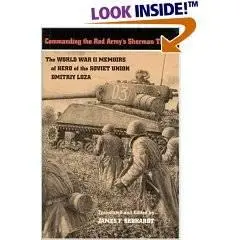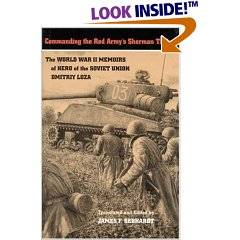Commanding the Red Army's Sherman Tanks: The World War II Memoirs of Hero of the Soviet Union Dmitriy Loza By Dmitriy Loza (Author) and James F. Gebhardt
University of Nebraska Press | Oct. 1996 | ISBN: 0803229208 | 173 Pages | HTML & Pics in RAR | 1,1Mb
University of Nebraska Press | Oct. 1996 | ISBN: 0803229208 | 173 Pages | HTML & Pics in RAR | 1,1Mb
Midwest Book Review
Hero of the Soviet Union Dmitriy Loza has carefully crafted his World War II experiences with American-provided Sherman tanks into a highly readable memoir. Between the fall of 1943 and August 1945, Loza fought in the Ukraine, Romania, Hungary, Czechoslovakia, and Austria. He commanded a tank battalion during much of this period and had three Shermans shot out from under him. Commanding The Red Army's Sherman Tanks is the first available detailed examination of the Red Army's exploitation of American war material during World War II and provides firsthand testimony on tactical command decisions, group objectives and how they were accomplished. It took the fall of the Soviet Empire before first-hand information like this could become part of military studies materials here in the west. James Gebhard's translation has made Dmitriy Loza's military memoirs easily accessible to both military professionals, World War II buffs, and nonspecialist general readers alike.
Product Description
Hero of the Soviet Union Dmitriy Loza has carefully crafted his World War II experiences with U.S.-provided Sherman tanks into a highly readable memoir. Between the fall of 1943 and August 1945, Loza fought in the Ukraine, Romania, Hungary, Czechoslovakia, and Austria. He commanded a tank battalion during much of this period and had three Shermans shot out from under him. Loza’s unit participated in such well-known combat actions as the Korsun-Shevchenkovskiy Operation, the Jassy-Kishenev Operation, and the battles for Budapest, Vienna, and Prague. Following the German surrender, Loza’s unit was sent to Mongolia, where it participated in the arduous trek across the Gobi Desert to attack the Japanese Kwantung Army in Manchuria.
This is the first available detailed examination of the Red Army’s exploitation of U.S. war matériel during World War II and one of the first genuine memoirs available from the Russian front. Loza also provides firsthand testimony on tactical command decisions, group objectives and how they were accomplished, and Soviet use of combat equipment and intelligence. Only after the collapse of the USSR and concomitant relaxing of prohibitions against publication of materials related to the Lend-Lease Program there could this account be made available.
10 of 10 people found the following review helpful:
For an solider or military historian, April 26, 2000
By Lance K. Mertz "Fantasy and Sci-Fi Reader" (Ward Cove, AK USA) - See all my reviews
As a former Armor officer I was captivated immediately. This is a story by a soldier's soldier. The stories are incredible, the action non-stop throughout. Colonel Loza is a true hero and warrior who tells a great story, albeit not in the flowing, perfect prose of the ivory tower historian, but that is what makes if all the more gut wrenching and believable. All tankers should read this one!
11 of 12 people found the following review helpful:
Wonderful account of Soviet use of Shermans during WW2, March 15, 2002
By David W. Nicholas (Montrose, CA USA) - See all my reviews
During WW2, the United States shipped a whole lot of Lend Lease material to the Soviet Union, and included in this equipment was a total of about 5,000 tanks. Most of those shipped were diesel-powered M4A2 Sherman tanks (emchas to their Soviet crews, after an abbreviation of the Russian pronunciation of M4) and this book is the memoir of the service of an officer who rode several of these tanks from the Ukraine to Czechoslovakia, then across the Gobi Desert to Mukden. It's well-written (not always a hallmark of Soviet war memoirs) and full of wonderful anecdotes, from whiskey bottles in the gun breeches to problems with the rubber-covered tracks and the high center of gravity. Strangely, Loza has more good things to say about the Sherman tank than Belton Cooper, who wrote Death Traps (which I just read). Cooper thinks the tanks were no match for their German counterparts, Loza argues that used properly, emphasizing speed and maneuverability, they could and did stand up to the Panthers and even Tigers tolerably well. The book includes several incredible stories, the sort of thing you wouldn't believe if the author hadn't witnessed the events themselves, and concludes with a bizarre kamikaze attack by Japanese planes on the tank column. My one gripe is that at points you feel you're missing something with regards to the author's private life (at one point he mentions that he has a family now, but you hear nothing of that otherwise; mention of his wounding and the events surrounding it are very sketchy) but that doesn't really merit a drop in my rating from the highest.
9 of 9 people found the following review helpful:
A FINE CHRONICLE OF THE USE OF OUR LEND-LEASE TANK, August 10, 1998
By DOUG.WARREN@AEROJET.COM (Camarillo, Calif. USA) - See all my reviews
I've always been interested as to how the people who used our World War II equpment, (not always the epitome in state-of-the-art), thought about the quality of what they received. It seems that the author had a high regard for the M-4 Sherman Tank, and this was from a national whose nation's specialty was the design and production of great tanks. He gives a fair comparison on the good and poor attributes of the Sherman and the application of that weapon in many battles and locales: from Europe to Asia. (Too bad the M-4 had such a small cannon compared to the German Tigers and Panthers: But precision shooting by the Soviets made up for the discrepancy). I learned a lot and am glad that Mr. Loza helped fill a need for information on this subject. (I was surprised that the Sherman was thought of so highly!) I would have rather had more details and depth in his book…but he wrote it terse, direct, and to the point (like the Romans used to style their military works…notab! ly Caesar). I heartily recommend it to anyone.



